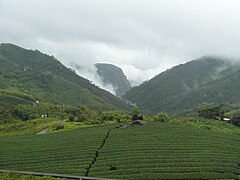High-mountain tea
This article needs additional citations for verification. (March 2015) |
| Gaoshan tea | |
|---|---|
 | |
| Type | Oolong |
| Other names | Kao-shan tea High mountain tea |
| Origin | Taiwan |
| Quick description | Light Oolong varieties with sweet, milky flavors and floral aromas[1][2] |

High-mountain tea or gaoshan tea (Chinese: 高山茶; pinyin: gāoshān chá; pronounced [káʊ.ʂán ʈʂʰǎ]) refers to several varieties of Oolong tea grown in the mountains of central Taiwan. It is grown at altitudes higher than 1,000 metres (3,300 ft) above sea level, and includes varieties such as Alishan, Dayuling, Yu Shan, Wushe, and Lishan.[1] The high humidity and natural precipitation in the high mountain ranges of Nantou and Chiayi Counties make the region a suitable environment for growing tea plants.[1] High Mountain Oolong is a tea that holds all of its original nutrients that are within the unfermented green tea. It does not hold the usual grass-like taste, hints of chestnut flavor paired with nutty aromas are often described.[3] The fermentation process that removes the harsh ingredients allows the tea to taste flavorful.[4]
Production
[edit]Gaoshan tea leaves are usually hand harvested, and grow slowly due to the thin air in high altitudes. Hence, the yield of gaoshan tea is relatively low every year.[2] There are two kinds of gaoshan tea based on the season: winter gaoshan is harvested during late October, and spring gaoshan is harvested during the middle of June.[citation needed]
It takes about 36 to 40 hours to process a batch of gaoshan tea. If weather allows, the handplucked leaves are spread on top of a tarp, where they develop aromas such as jasmine, rose and geranium.[citation needed] The tea is folded to bruise the leaf for oxidation and is then transferred to another tray to ferment and wither for eight hours. It is then packaged as "handkerchief tea", where farmers emphasize on the quality of the tea rather than the quantity.[citation needed]
References
[edit]- ^ a b c "Guide to Taiwan Teas". The Fragrant Leaf. Retrieved 2017-01-10.
- ^ a b "High Mountain Gao Shan: Spring and Winter Tea". Tea Trekker. Retrieved 2017-01-10.
- ^ Wang, Cong-ming; Du, Xiao; Nie, Cong-ning; Zhang, Xiang; Tan, Xiao-qin; Li, Qian (2022-06-20). "Evaluation of sensory and safety quality characteristics of "high mountain tea"". Food Science & Nutrition. 10 (10): 3338–3354. doi:10.1002/fsn3.2923. ISSN 2048-7177. PMC 9548367. PMID 36249988.
- ^ "High Mountain Taiwan Oolong Tea & The Chinese Art of Tea". www.oolong-tea.org. Retrieved 2020-02-19.


 French
French Deutsch
Deutsch